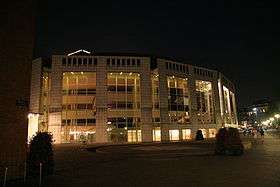Stopera
Coordinates: 52°22′02″N 4°54′06″E / 52.36722°N 4.90167°E

The Stopera is a building complex in Amsterdam, the Netherlands, housing both the city hall of Amsterdam and the Dutch National Opera & Ballet, the principal opera house in Amsterdam that is home of Dutch National Opera, Dutch National Ballet and Holland Symfonia. The building was designed by Cees Dam and Wilhelm Holzbauer.
The name "Stopera" is a portmanteau of stadhuis (Dutch: "city hall") and opera.

The Stopera is located in the center of Amsterdam at a bend of the Amstel River between Waterlooplein Square and the Zwanenburgwal Canal, on a plot of land called Vlooienburg, which was reclaimed in the 16th century. The opera house building is shaped like a huge, massive block, with a curved front facing the city. Its facade is covered in a red-orange brick and corrugated metal panels. The curved face of the theatre is faced with white marble punctuated by large windows that provide panoramic views of the river from the curved interior foyers and multi-level terraces.
Next to the Stopera is the Joods Verzetsmonument, a 1988 monument to the Jewish victims of World War II. A remembrance of the Kristallnacht is held at the monument every year.
History

The construction of the Stopera was at least 60 years in the making. As early as 1915, discussions were held about building a new opera house as well as a new city hall. Various sites were considered for the new city hall, until finally Waterlooplein square was chosen.
The Amsterdam city council established a commission in 1955 to create a design with the architectural firm of Berghoef and Vegter. After almost ten years, the council rejected their final proposal in 1964 and held a competition in 1967 for a new design. The council selected a design by Viennese architect Wilhelm Holzbauer. However, plans for the new city hall were delayed again by budget constraints, as were the opera house plans.
In 1979, it was proposed that the city hall and opera house should be combined into one complex. The opera and the Dutch National Ballet would have a shared performance space. In 1980 the Amsterdam city council approved the new design by Cees Dam and Wilhelm Holzbauer. Approval from the provincial and national governments followed in 1981.[1]
The Stopera was a controversial project that met with heavy protests, particularly from local counterculture and leftwing groups like the squatter movement and Provo movement, leading to riots when construction began in 1982. The project went seriously over budget and the final cost was 112 million Dutch guilders more than originally budgeted.
The opera officially opened on September 23, 1986; the new city hall opened two years later.
References
Further reading
| Wikimedia Commons has media related to Stopera. |
- Max van Rooy en Bas Roodnat De Stopera, een Amsterdamse geschiedenis (1986; Uitgeverij Rap), Dutch publication.